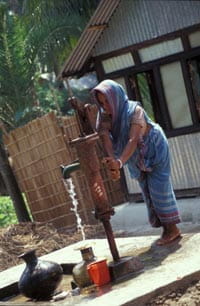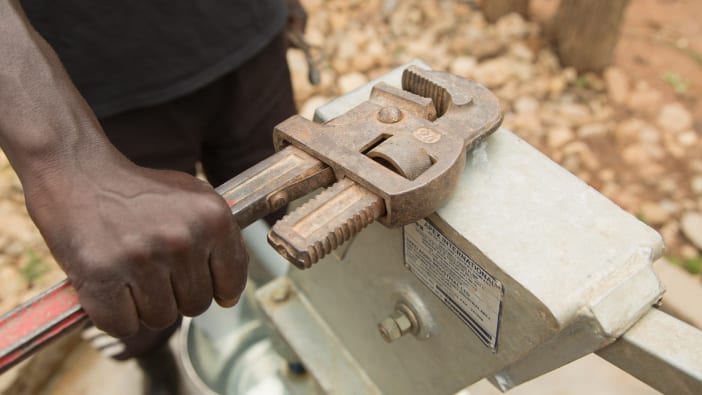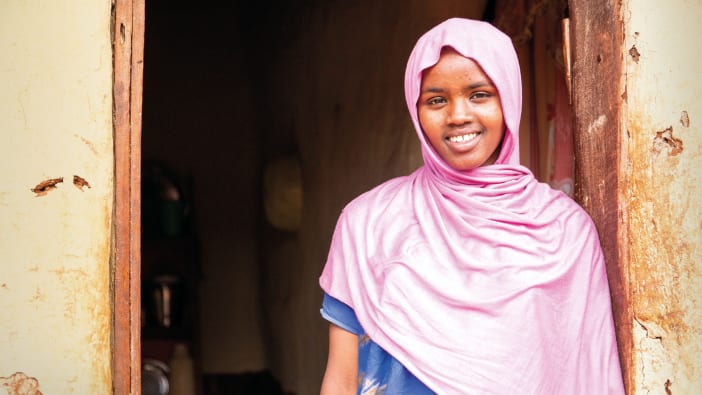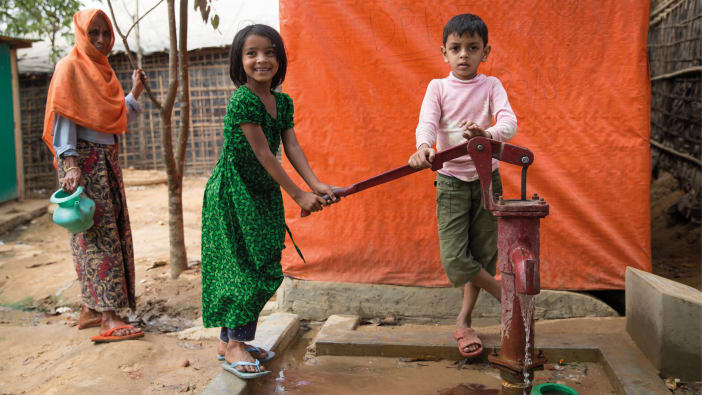by Daniel Schotanus.

Articles
Handpumps: A losing battle?
Why do we hear so few success stories of handpumps?
2002 Available in English, French, Spanish and Portuguese

Photo: Jim Loring/Tearfund
Why do we hear so few success stories of handpumps? During the early stages of planning, building and initial use, there are many claims of success. However, there are few reports on the state of handpump projects after three, five or even ten years of use. Is it because little monitoring and evaluation is carried out? Has interest moved to other projects or regions? Or is it because the handpump projects themselves have proved only a short-term success?
Most of us working to improve water supplies know the sorry sight of lonely, broken-down pumps. One can only guess how long ago the pump was proudly presented to the community. A local official probably made the first few forceful swings and declared a decisive blow in the war on famine, disease and poverty. But the clear water pouring out is now only a memory for local people and a photograph in the final project report.
Last December, I visited a water programme managed by an Ethiopian NGO, eight years after working with them. I sat with my previous counter-parts and reflected on the good times we had. Talk turned to work issues. It soon became clear that the dream we had ten years earlier, about the NGO encouraging local multiplication of handpumps sustained by community financing, had not really developed. The idea of sustainable water development had not lived up to our expectations.
We visited one of the first handpumps installed by the programme 12 years earlier and found it nicely fenced and still in use. However, many of the other handpumps were no longer successful. Sometimes the pump had broken down; sometimes the water committee had failed to manage and maintain the pump; sometimes the community had failed to provide financial contributions. These concerns raise a number of important issues that we need to consider before deciding whether handpumps are a wise choice for community water supply.
Appropriate service level
|
Service levels for community water supply | |||
|
Level |
Type of service |
Litres of water used each day for each user |
Cost |
|
5 |
house connection |
100-150 |
high |
|
4 |
yard tap |
50-100 |
high |
|
3 |
standpipe |
10-40 |
moderate |
|
2 |
handpump |
10-40 |
low |
|
1 |
improved traditional |
10-40 |
very low |
|
0 |
traditional |
10-40 |
very low |
|
Arlosoroff (1987) | |||
Researchers into water supplies suggest a useful scale to describe the level of water supply. Traditional water sources with no improvements – for example river water, a pond, water hole, shallow unlined well or unprotected spring – are regarded as zero level. The first level of improvements upgrade these with simple measures to protect the source from contamination. These could include lining a well, using a bucket and rope or protecting a spring. This can result in a very significant improvement in water quality. Handpumps are listed as the second out of six levels.
Handpumps offer improved protection, more water and an easier way of obtaining water by pumping. The closed well cover protects the water source from any contamination from the surface. The amount of water varies depending on the type of pump, the depth of the water table below the surface and the strength of the user. Handpumps can usually supply 0.5–1 cubic metre of water per hour, and 10–12 year old children should be strong enough to work the pump.
Higher levels of service such as public standpipes, outside taps and in-house connections provide more water at greater convenience but at much higher costs. These systems require considerable technical and economic resources and are usually beyond the means of users and authorities to establish and maintain.
Village level operation and maintenance
Over the last 15 years, village level operation and maintenance of hand-pumps (VLOM) has become a key consideration for handpump design. Many different manufacturers now claim this for their own design of pump. The World Bank originally promoted this concept and it includes these criteria:
- Easily maintained by a village care-taker, requiring minimal skills and few tools
- Manufactured in-country so that spare parts are easily available
- Strong and reliable under field conditions
- Cost-effective.
Village level operation and maintenance also applies to the management of the handpumps. This means the community needs to take ownership of the use and maintenance of the pump. The ownership and management of maintaining pumps should mean that the community:
- chooses when to service the pumps
- chooses who will service the pumps
- pays for the service.
Handpump failures
Our project in Ethiopia worked with a local maintenance team. After a number of pumps were established, the project continued to employ this team because:
- Village caretakers often did not practise preventative maintenance but waited for problems to develop.
- Spares were often not available.
- Breakdowns occurred which were beyond the capacity of the village community to repair.
- It was against the financial interest of the project maintenance team to give responsibility to local communities.
In both remote and urban areas, many caretakers are very careful with money. People think there is no need to replace a part that is still working. This may mean that parts are not replaced until they show definite problems or have actually broken down. It may also prove very difficult to obtain spare parts locally and without them no preventative maintenance can take place.
However, depending on how often the pump is used, all parts will eventually need replacing once their intended life-time is past. The pump may still be usable after a small part has worn out or broken, but this can lead to considerable and permanent damage. Expensive new parts and outside help may then be necessary to repair extensive damage.
If funds are available for a central maintenance team, then emergency repairs can be done and communities continue to benefit from working pumps (assuming the maintenance teams live up to expectations!). But generally, funding for such teams is unlikely to last.
In Ethiopia, both government and NGOs have expected too much from the communities’ initial willingness to contribute to providing water supplies. Outside funding and the need for rapid results, often mean too little attention is given to building up local capacity and participation.
‘Ownership’ of the water scheme often just means the completed pump is ‘given’ to the community once built. Too little time is taken to allow the community to manage the planning and implementation process and to take ownership of the water supply scheme from the start. Local contributions are often measured in terms of labour and contributions of building materials or food. Who can blame local people for being hesitant about contributing to something that seems to be owned by outsiders?
Research carried out by Ethiopian students of the IHE-UNESCO Institute for Water Education suggests that communities are usually able to pay for their own water supply schemes. The required contribution to maintenance of water supply schemes is usually much less than 1% of annual income, which should be acceptable even at subsistence level. Only during crisis situations were people unable to contribute.
There is a clear need to rethink our approaches. Good handpumps exist, and technical solutions are available. Management of handpumps is the real issue. For village level operation and management to work, the capacity building of those responsible for operation and maintenance is essential. They need training in proper management of supplies, spares and finances. Our planning and support need to match local people’s willingness to contribute.
Daniel Schotanus works in the Department of Management and Institutions at IHE-UNESCO Institute for Water Education, PO Box 3015, 2601 Delft, the Netherlands. He has many years experience as a water engineer in Ethiopia. E-mail: [email protected] IHE website: www.ihe.nl
Similarly Tagged Content
Share this resource
If you found this resource useful, please share it with others so they can benefit too.

Subscribe to Footsteps magazine
A free digital and print magazine for community development workers. Covering a diverse range of topics, it is published three times a year.
Sign up now - Subscribe to Footsteps magazine






